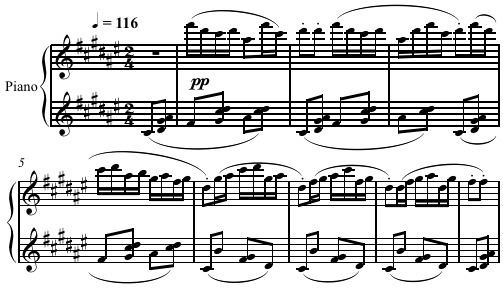 | ||
Ma mère l'Oye (Mother Goose; "Oye" is correctly capitalized, being a proper name) is a musical work by French composer Maurice Ravel.
Contents
Piano versions
Ravel originally wrote Ma mère l'Oye as a piano duet for the Godebski children, Mimi and Jean, ages 6 and 7. Ravel dedicated this work for four hands to the children (just as he had dedicated an earlier work, Sonatine, to their parents). Jeanne Leleu and Geneviève Durony premiered the work at the first concert of the Société Musicale Indépendante on 20 April 1910.
The piece was transcribed for solo piano by Ravel's friend Jacques Charlot the same year as it was published (1910); the first movement of Ravel's Le tombeau de Couperin was also dedicated to Charlot's memory after his death in World War I.
Both piano versions bear the subtitle "cinq pièces enfantines" (five children's pieces). The five "pieces" were as follows:
On several of the scores, Ravel included quotes to indicate clearly what he was trying to invoke. For example, for the second "piece":
"Il croyait trouver aisément son chemin par le moyen de son pain qu'il avait semé partout où il avait passé; mais il fut bien surpris lorsqu'il ne put retrouver une seule miette: les oiseaux étaient venus qui avaient tout mangé. (Ch. Perrault)"["He believed he'd easily find his way because of the bread that he'd strewn all along his path; but he was very surprised to find not a single crumb: the birds had come and eaten everything." (Charles Perrault)]Sleeping Beauty and Little Tom Thumb were based on the tales of Charles Perrault, while Little Ugly Girl, Empress of the Pagodas was inspired by a tale (The Green Serpent) by Perrault's "rival" Madame d'Aulnoy. In this movement, Ravel takes advantage of the pentatonic scale. Beauty and the Beast is based upon the version of Jeanne-Marie Le Prince de Beaumont. The origin of The Fairy Garden is not entirely known, although the ballet version interprets this as Sleeping Beauty being awakened in the garden by her prince. The "Mouvt de marche" of Little Ugly Girl uses quartal harmony:
Orchestrated work
In 1911 Ravel orchestrated the five-piece suite, and in this form it is most frequently heard today.
Later the same year he also expanded it into a ballet, separating the five initial pieces with four new interludes and adding two movements at the start, Prélude and Danse du rouet et scène. The ballet premiered on 29 January 1912 at the Théâtre des Arts in Paris. The eleven numbers are:
Instrumentation
Ma mère l'Oye was scored for the following orchestra:
Electronic Versions
On his 1980 album Bolero Japanese synthesizer artist Isao Tomita recorded the five movements of the piano version.
On his 1974 LP So What American guitarist Joe Walsh recorded the first piano movement, which he simply titled "Pavanne", on the synthesizer.
